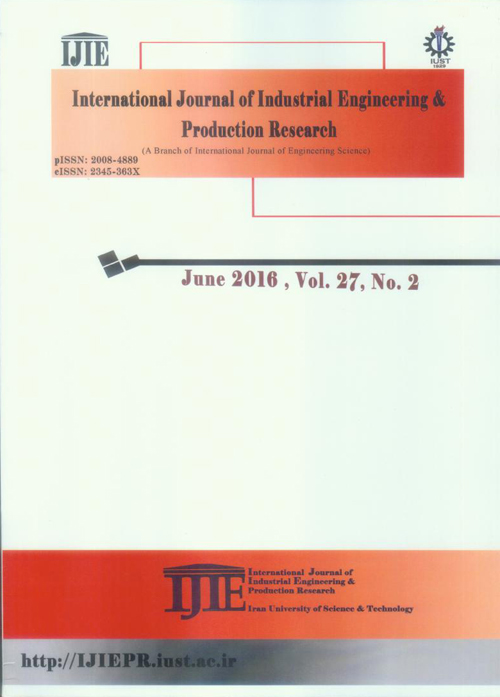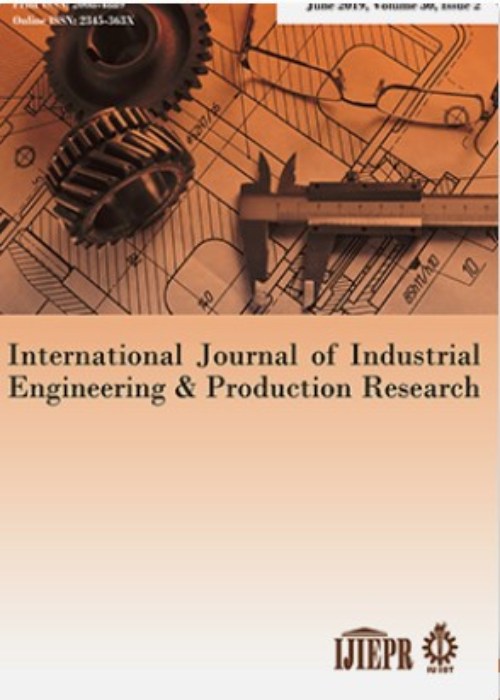فهرست مطالب

International Journal of Industrial Engineering and Productional Research
Volume:27 Issue: 2, Jun 2016
- تاریخ انتشار: 1395/03/31
- تعداد عناوین: 8
-
-
Pages 87-98Manufacturing process frequently employs optimization of machining parameters in order to improve product quality as well as to enhance productivity. The material removal rate is a significant indicator of the productivity and cost efficiency of the process. Taguchi method has been implemented for assessing favorable (optimal) machining condition during the machining of nylon by considering three important cutting parameters like cutting speed, feed rate and depth of cut during machining on CNC. The objective of the paper is to find out, which process parameters having more impacts on material removal rate during turning operation on nylon using analysis of variance (ANOVA). An Orthogonal array has been constructed to find the optimal levels of the turning parameters and further signal-to-noise (S/N) ratio has been computed to construct the analysis of variance table. The results of ANOVA shown that feed rate has most significant factor on MRR compare to cutting speed and depth of cut for nylon. The confirmation experiments have conducted to validate the optimal cutting parameters and improvement of MRR from initial conditions is 555.56%.Keywords: Taguchi method, Optimization, CNC Turning, Cutting Parameters, MRR
-
Pages 99-107This paper addresses a production and outbound distribution scheduling problem in which a set of jobs have to be process on a single machine for delivery to customers or to other machines for further processing. We assume that there is a sufficient number of vehicles and the delivery costs is independent of batch size but it is dependent on each trip. In this paper, we present an Artificial Immune System (AIS) for this problem. The objective is to minimize the sum of the total weighted number of tardy jobs and the batch delivery costs. A batch setup time has to be added before processing the first job in each batch. Using computational test, we compare our method with an existing method for the mentioned problem in literature namely Simulated Annealing (SA). Computational tests show the significant improvement of AIS over the SA.Keywords: Supply chain management, Scheduling, Distribution, Batching, Artificial immune system
-
Pages 109-120Efficiency and effectiveness of the organization is result ofmanagement performance and supply chain structure.Today, several factors in selection the supplier or the best combination of suppliers have been identified that this issue would increase the complexity of suplier selecting.This study investigates the application of Fuzzy Delphi in order to identify the important factors in selecting a supplier in the steel industry and then provide a comprehensive and holistic model of supplier selection to overcome the complexity.In this context, Interpretive Structural Modeling (ISM) unlike other methods, the holistic, dealing with supplier selection to prioritize components-surfacing and identifying key components, so industry leaders will provide comperhensive map to select the best combination based on their.The results of this study indicate that "technically possible", "financial health" and "geography situation" are the basic components to the selection of suppliers.Keywords: supply chain, supplier selection, Fuzzy Delphi, Interpretive Structural Modeling (ISM)
-
Pages 121-139In this paper, a stochastic cell formation problem is studied using queuing theory framework and considering reliability. Since cell formation problem is NP-Hard, two algorithms based on genetic and modified particle swarm optimization (MPSO) algorithms are developed to solve the problem. For generating initial solutions in these algorithms, a new heuristic method is developed, which always creates feasible solutions. Moreover, full factorial and Taguchi methods are implemented to set crucial parameters in the solutions procedures. Deterministic method of branch and bound (B&B) algorithm is used to evaluate the results of modified particle swarm optimization algorithm and the genetic algorithm. The results indicate that proposed algorithms have better performance in quality of the metaheurstic algorithms final answer and solving time compared with the method of Lingo softwares B&B algorithm. The solution of two metaheurstic algorithms is compared by t test. Ultimately, the results of numerical examples indicate that considering reliability has significant effect on block structures of machine-part matrixes.Keywords: Cell formation problem, Queuing theory, Particle swarm optimization algorithm, Genetic
-
Pages 141-148Process capability indices (PCIs) can be used as an effective tool for measuring product quality and process performance. In classic quality control there are some limitations which prevent a deep and flexible analysis because of the crisp definition of PCA‟s parameters. Fuzzy set theory can be used to add more flexibility to process capability analyses. In this study, the fuzzy X ba and MRx ba control charts are introduced to monitor continuous production process in triangular fuzzy state. Also, fuzzy PCIs are produced when SLs and measurements are triangular fuzzy numbers (TFN). For this aim, a computer program is coded in Matlab software. The fuzzy control charts is applied in Yazd fiber production plant. The results show that in continuous production processes, the better analysis will be performed by using fuzzy measurements. Also, based on the fuzzy capability indices, we can have a flexible analysis of the process performance.Keywords: Fuzzy process capability indices, Specification limits, Continuous production process
-
Pages 149-166In this research we have presented a local model for implementing systems engineering activities in optimized acquisition of electronic systems in Electronic High-Tech Industrial. In this regard, after reviewing the literature and the use of documents, articles and Latin books, we have collected system acquisition life cycle models from different resources. after considering the criteria of the mentioned industry, we have designed two questionnaires and distributed them among some experts of industry and university. The Population studied here were all of the specialists of mentioned industry and our sample consist of 17 experts in this field. As the main focus of this research is on experts opinions, we used purposive sampling. Finally, we present local model using the results of the questionnaires and considering the standards, requirements and system engineering processes during system acquisition stages and then match them with our case study. this research includes some innovations such as: flexibility of model under different conditions, choosing the appropriate positions for applying systems engineering reviews, and also the use of foresight issue in the initial phase of model, which have been neglected in other presented models in previous researches.Keywords: System Acquisition, Electronic High, tech Industrial, Systems Engineering, System Life Cycle, Acquisition Local Model
-
Pages 167-178Scheduling has become an attractive area for artificial intelligence researchers. On other hand, in today's real-world manufacturing systems, the importance of an efficient maintenance schedule program cannot be ignored because it plays an important role in the success of manufacturing facilities. A maintenance program may be considered as the heath care of manufacturing machines and equipments. It is required to effectively reduce wastes and have an efficient, continuous manufacturing operation. The cost of preventive maintenance is very small when it is compared to the cost of a major breakdown. However, most of manufacturers suffer from lack of a total maintenance plan for their crucial manufacturing systems. Hence, in this paper, we study a maintenance operations planning optimization on a realistic variant of parallel batch machines manufacturing system which considers non-identical parallel processing machines with non-identical job sizes and fixed/flexible maintenance operations. To reach an appropriate maintenance schedule, we propose solution frameworks based on an Artificial Immune Algorithm (AIA), as an intelligent decision making technique. We then introduce a new method to calculate the affinity value by using an adjustment rate. Finally, the performance of proposed methods are investigated. Computational experiments, for a wide range of test problems, are carried out in order to evaluate the performance of methods.Keywords: Artificial Intelligence, Manufacturing Systems, Preventive Maintenance, Total Maintenance Program
-
Pages 179-187In this research we have presented a local model for implementing systems engineering activities in optimized acquisition of electronic systems in Electronic High-Tech Industrial. In this regard, after reviewing the literature and the use of documents, articles and Latin books, we have collected system acquisition life cycle models from different resources. after considering the criteria of the mentioned industry, we have designed two questionnaires and distributed them among some experts of industry and university. The Population studied here were all of the specialists of mentioned industry and our sample consist of 17 experts in this field. As the main focus of this research is on experts opinions, we used purposive sampling. Finally, we present local model using the results of the questionnaires and considering the standards, requirements and system engineering processes during system acquisition stages and then match them with our case study. this research includes some innovations such as: flexibility of model under different conditions, choosing the appropriate positions for applying systems engineering reviews, and also the use of foresight issue in the initial phase of model, which have been neglected in other presented models in previous researches.Keywords: System Acquisition, Electronic High, tech Industrial, Systems Engineering, System Life Cycle, Acquisition Local Model


